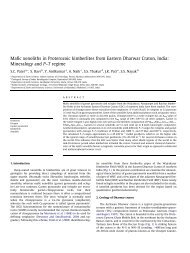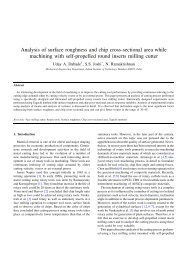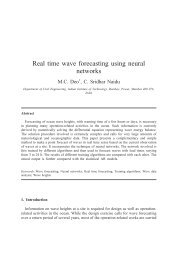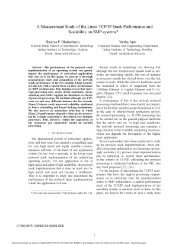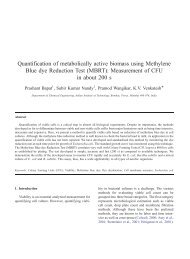Infrared signature studies of aerospace vehicles - DSpace at IIT ...
Infrared signature studies of aerospace vehicles - DSpace at IIT ...
Infrared signature studies of aerospace vehicles - DSpace at IIT ...
Create successful ePaper yourself
Turn your PDF publications into a flip-book with our unique Google optimized e-Paper software.
missile program. By 1967, these parallel programs<br />
led to the development <strong>of</strong> MANPADS; which are<br />
cheap and easy to use, and prolifer<strong>at</strong>ed world-wide.<br />
Several variants <strong>of</strong> IR-guided surface-to-air missiles<br />
(SAMs) and air-to-air missiles (AAMs) were developed<br />
for specific applic<strong>at</strong>ions (Ref. Table 1 for a<br />
represent<strong>at</strong>ive list). The MANPADS proved to be<br />
especially lethal against low flying aircraft and<br />
helicopters [4]. So far, about one million MAN-<br />
PADS have been manufactured worldwide [2], and<br />
approxim<strong>at</strong>ely 500,000 missiles are in circul<strong>at</strong>ion [8].<br />
2.2. Stealth aircraft<br />
Till 1970, aircraft survivability as a discipline<br />
in aircraft design was not given due importance.<br />
A revolution in aircraft design priorities started with<br />
the first program to design stealth aircraft, Have<br />
Blue [9,10]. After mid-1980, aircraft survivability<br />
was established as a major discipline, and today,<br />
military forces consider survivability enhancement<br />
as the foremost design fe<strong>at</strong>ure. The primary aim <strong>of</strong><br />
the Have Blue program was to defe<strong>at</strong> the RADARbased<br />
defence systems, but due consider<strong>at</strong>ion to<br />
aircraft IR <strong>sign<strong>at</strong>ure</strong>s was also given [11]. The first<br />
aircraft manufactured with stealth capabilities,<br />
F-117A, were flown in June 1981 [12]. In the Gulf<br />
War, F-117A aircraft constituted only 2–3% <strong>of</strong> the<br />
total 1900 fighters and bombers, but <strong>at</strong>tacked 40%<br />
<strong>of</strong> the str<strong>at</strong>egic targets. A single F-117A sortie is<br />
equivalent to 95 sorties <strong>of</strong> aircraft used earlier in the<br />
Vietnam War [9].<br />
2.3. Recent developments in low observables<br />
For reducing RCS, F-117A, A-12, F/A-22, RA-66<br />
and B2 have modified the engine inlet and exhaust,<br />
have high wing sweep angles, and do not have<br />
bumps, bulges, and holes [13]. Technology for<br />
Table 1<br />
Common he<strong>at</strong>-seeking missiles<br />
Missile<br />
Type<br />
Missiles<br />
SAM CHAPARRAL, REDEYE, RAM, STINGER,<br />
B/RMP, SA-7, SA-9, SA-13, SA-14, SA-16, SA-18,<br />
Tan-Sam<br />
AAM AIM 4D, AIM 9L/M, MICAL, IRIS, Sidewinder,<br />
Asraam, AA-2, AA-3, AA-5, AA-6, AA-11, Magic-2,<br />
Python-3, CAA-1, CAA-2, Piranha, K-13A<br />
ARTICLE IN PRESS<br />
reduction <strong>of</strong> IR emissions from hot engine parts,<br />
plume, and fuselage are also being developed by<br />
aircraft manufacturers. The <strong>at</strong>mospheric transmission<br />
<strong>of</strong> IR radi<strong>at</strong>ion has been modelled by codes; e.g.<br />
LOWTRAN, MODTRAN, HITRAN (which differ<br />
in their spectral resolution). In 1998, the US Army<br />
initi<strong>at</strong>ed the Advanced Thre<strong>at</strong> IR Countermeasures<br />
System (ATIRCM) and Directional IR Countermeasures<br />
System (DIRCM) for aircraft [14]. The US<br />
Military initi<strong>at</strong>ed the incorpor<strong>at</strong>ion <strong>of</strong> integr<strong>at</strong>ed<br />
IRCMs on 1047 helicopters, which is expected to be<br />
completed in a phased manner by 2014 [15]. The list<br />
includes Special Oper<strong>at</strong>ions Blackhawks, Special<br />
Oper<strong>at</strong>ions Chinooks, Army Apache, Army Blackhawks,<br />
Army Chinooks, and Army Kiowa warrior<br />
helicopters.<br />
There have been several US p<strong>at</strong>ents on IR<br />
<strong>sign<strong>at</strong>ure</strong> reduction and management-rel<strong>at</strong>ed technologies,<br />
which include the following: (i) modific<strong>at</strong>ion<br />
<strong>of</strong> engine exhaust geometry to enhance mixing<br />
<strong>of</strong> exhaust gases with the <strong>at</strong>mosphere [16–26], (ii)<br />
electrical he<strong>at</strong>ing [27], he<strong>at</strong> pipe cooling [28], liquid<br />
evapor<strong>at</strong>ive cooling [29], chemical tre<strong>at</strong>ment <strong>of</strong><br />
aircraft skin [30,31], (iii) surface geometry modific<strong>at</strong>ions<br />
[32], (iv) surface emissivity alter<strong>at</strong>ion<br />
[30,31,33,34], (v) plume <strong>sign<strong>at</strong>ure</strong> tailoring [35],<br />
(vi) IRCMs [36], etc.<br />
3. Sources <strong>of</strong> IR <strong>sign<strong>at</strong>ure</strong> and their estim<strong>at</strong>ion<br />
The discrimin<strong>at</strong>ion between IR emissions from<br />
the target and the surrounding background leads to<br />
target detection. Engine hot parts, exhaust plume,<br />
rear fuselage, and aerodynamically he<strong>at</strong>ed skin, are<br />
the important sources <strong>of</strong> IR emission in an aircraft;<br />
as illustr<strong>at</strong>ed in Fig. 1(a). The total IR <strong>sign<strong>at</strong>ure</strong> [37]<br />
<strong>of</strong> an aircraft can be expressed as [Ref. Fig. 1(b)]:<br />
Total <strong>sign<strong>at</strong>ure</strong> ¼ aircraft hot parts emission+aircraft<br />
plume emission+skin emission+reflected skyshine+reflected<br />
earthshine+reflected sunshine.<br />
3.1. IR emissions<br />
The IRSL depends on the contrast gener<strong>at</strong>ed due<br />
to the difference between IR radiance (emission and<br />
reflection) level <strong>of</strong> the target and its background.<br />
The IR emission <strong>of</strong> a black body is a function <strong>of</strong><br />
frequency and absolute temper<strong>at</strong>ure, as given by<br />
Planck’s Law as (Ref. e.g. [6])<br />
EBl ¼<br />
2phpn 3<br />
c 2 expðhpn=BTÞ 1<br />
221<br />
: (1)



